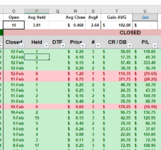NamssoB
Board Regular
- Joined
- Jul 8, 2005
- Messages
- 76
- Office Version
- 365
- 2016
- Platform
- Windows
I have a list of stock trades, all dated in column O (from O5:O5000). I have a profit/loss in column U starting at U5. I have a drop down in U1 to select Month (3-letter abbreviation), as well as the word "Total". My goal is to be able to select Jan from the drop down, and have it show me my profit from January. Change to Feb, and I only see profit from Feb. Change to Total, and it shows me total profit.
I want to select Jan, Feb, Mar, etc., in the drop down, and have cell U2 show me a total for all items with a date within the month selected in the drop down. For example:
U1: Drop down, with a list (Total, Jan, Feb, Mar, ...)
U2: Formula I'm trying to figure out: SUM U5:U5000 for any entries with a date (Column O5:O5000, 12-Feb, 5-Jan, etc) that matches the month selected in U1
U5... Values I want to sum
O5... Dates
I know I can use TEXT(O5,"mmm") to grab the 3-letter month and compare it to U1, but I can't figure out how to get that into my formula in U2.
And when I select Total in U2, I just want to add everything up, the entire column U starting at U5.
Ideas?
I want to select Jan, Feb, Mar, etc., in the drop down, and have cell U2 show me a total for all items with a date within the month selected in the drop down. For example:
U1: Drop down, with a list (Total, Jan, Feb, Mar, ...)
U2: Formula I'm trying to figure out: SUM U5:U5000 for any entries with a date (Column O5:O5000, 12-Feb, 5-Jan, etc) that matches the month selected in U1
U5... Values I want to sum
O5... Dates
I know I can use TEXT(O5,"mmm") to grab the 3-letter month and compare it to U1, but I can't figure out how to get that into my formula in U2.
And when I select Total in U2, I just want to add everything up, the entire column U starting at U5.
Ideas?






